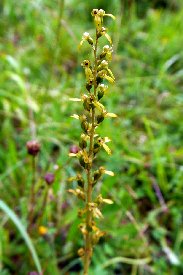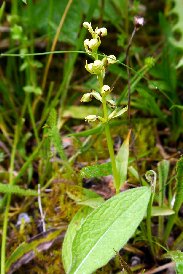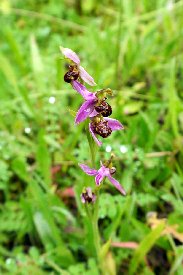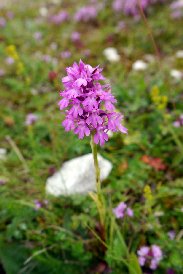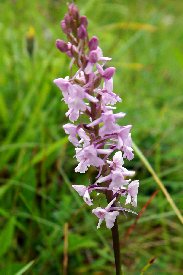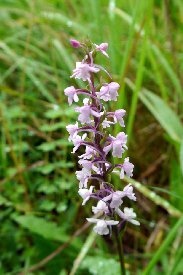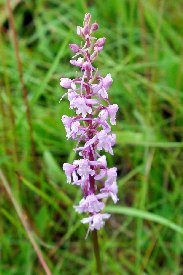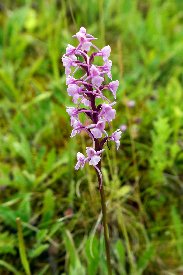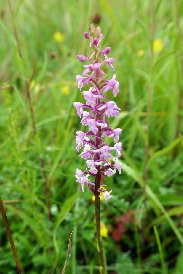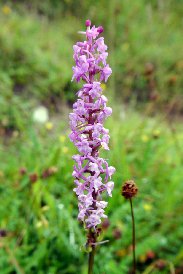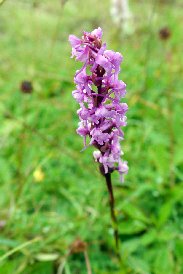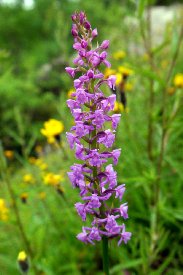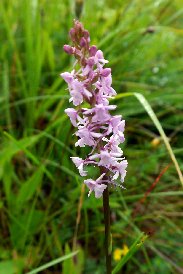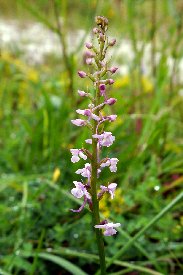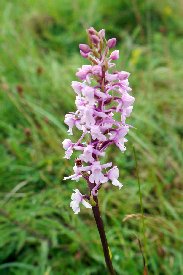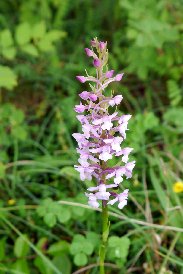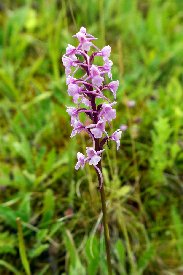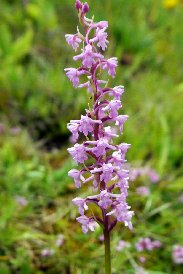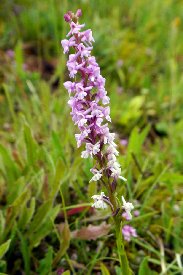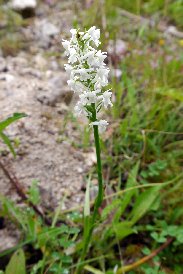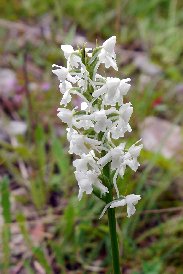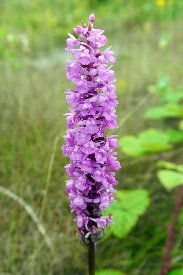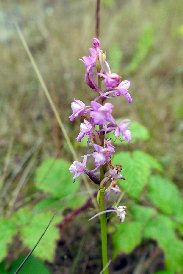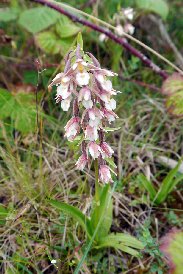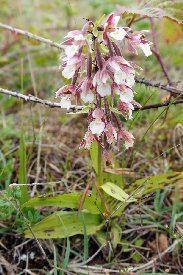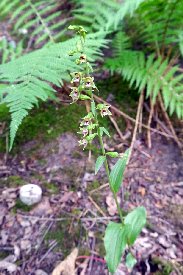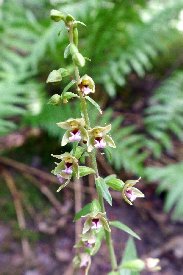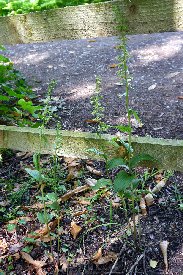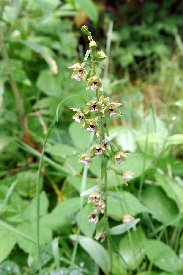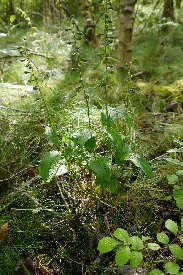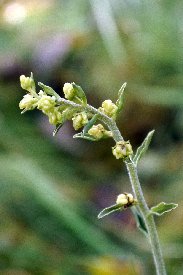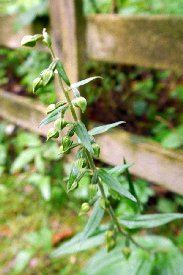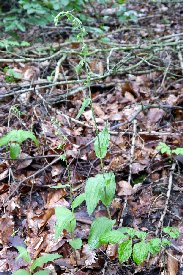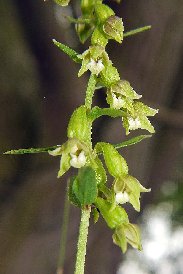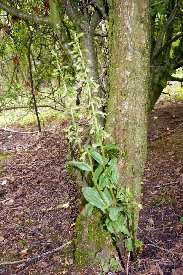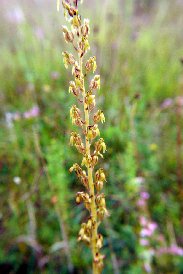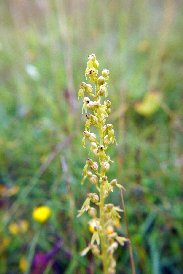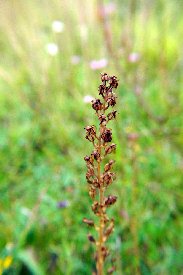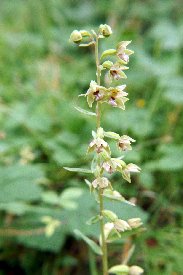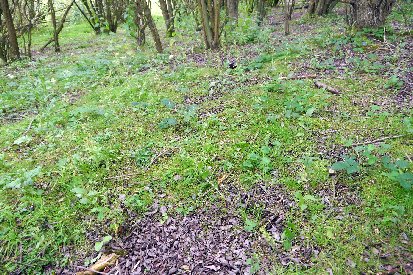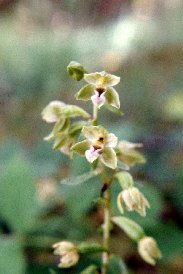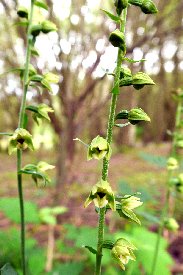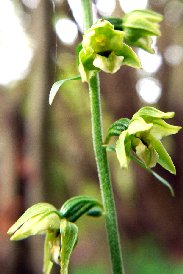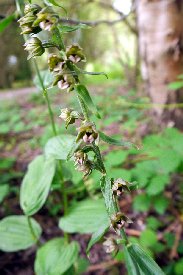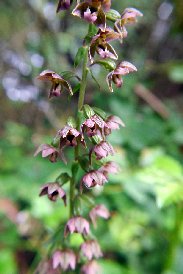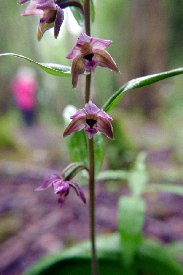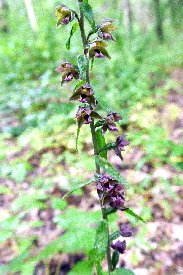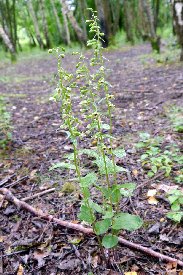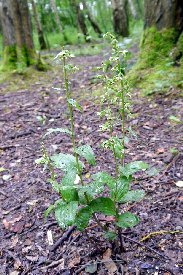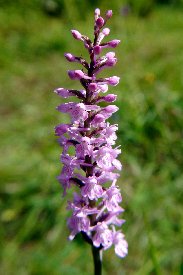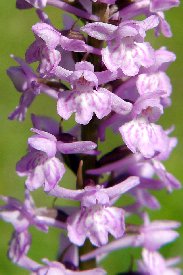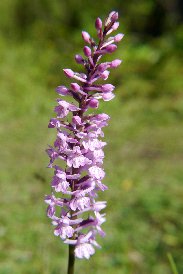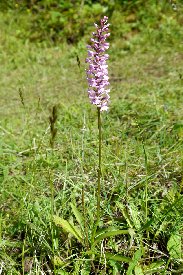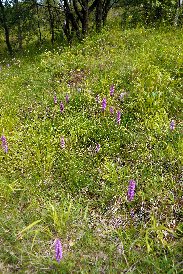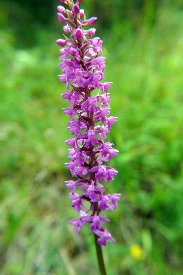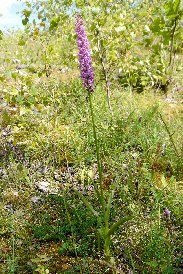|
|
||||||||||||||||||
|
|
||||||||||||||||||
 |
|
Eryrys, 13th July 2019 (SJ 20309 56903) Return visits are becoming routine again, but what we see is not necessarily so. There are Common Spotted Orchids, while the Common Twayblades and Frog Orchids are both developing fruiting bodies. We re-discover the Bee Orchids see two years ago, and find Pyramidal Orchids here for the very first time - remarkable that we could have missed them previously. However it is Fragrant Orchid season, and they are in abundance in a range of colours and shades, and a variety of forms. Studying the photos it seems as if both Marsh Fragrant Orchids and Chalk Fragrant Orchids grow here side by side, and this opens up the possibility of hybrids. Naturally the differences from either parent would be subtle, but it seems reasonable to assume either features of both on one plant, or features halfway between the two. The latter would be most likely, but harder to decide upon.
Thus if this site does have both Gymnademnia species present there would certainly be some hybdridisation, going both ways and introgression. I suspect that it highly likely that at least one species of moth is capable of transferring pollen between both species. As hybrids between the two species have yet to be formally named we likley have here Gymnadenia conopsea x G. densiflora and Gymnadenia densiflora x G. conopsea depending on which were the matrnal and paternal parents of each hybrid. Despite all this the prevailing opinion is that these are all Chalk Fragrant Orchids, and the overall flower form and spike appearance bears this out. Runcorn area 16th July 2019 (SJ 52792 79639) Orchids can be quite opportunistic, populating new and sometimes unlikely sites; like a chemical waste ground between the factories and the M56 near Runcorn in Cheshire. Sites like these are more frequent than one would imagine. There are parallels with Nob End and Neumann's Flash, especially with the latter having both Marsh Fragrant Orchids (plentiful and often with crowded flower spikes) and Marsh Fragrant Orchids colonising the areas. Interesting but not yet a site revisiting. However the main reason to come here is the report of Dune Helleborine in the adjoining woodland. Not the most welcoming of orchid sites as we have to circumnavigate the fly-tipping first. We find only one example and it seems to be okay; others report three! How many more odd locations will this species be found in? Delamere Forest, 16th July 2019 (SJ5538671345) The Runcorn visit affords us a chance to pop into the Delamere Forest to look upon the Helleborines there. There is no sign of the Broad-leaved Helleborines seen two years ago, but the Dune Helleborines are doing well. There is quite a small group growing by the new fencing at the cross-roads at the N.E. eand of the mere, and while the mere-side population along the track has dwindled, there are many to be found in the longer vegetation on the pine forest side. Brymbo Pool 20th July 2019 (SJ 28740 53724) A return here reveals that Helleborines here are, as expected, Broad-leaved Helleborines. Only the odd flower is out, but the species ID is simple. There is a `treat' though. One plant looks to have some sort of genetic flower development defect that is different to that see at Nant-y-Ffrith. Tanyfron 20th July 2019 (SJ 29338 52846) Another on-the-way-home stop off. This is a site I heard about in 2018 (thanks Martyn) and though it is likely too early I may as well have a look. There are about two dozen Broad-leaved Hellborines along a footpath here, still 10-14 days from flowering. They are perhaps 3/4 mile from the other Tanyfron BLH seen last year. Are they descendants of a single population divided from each other, first by industrialisation of the Brymbo Steelworks and later by residential construction, or are they separate colonisations? Does it matter? Of course it does. These are orchids we are talking about! A few Common Spotted Orchids are also present. Alyn Waters Country Park 21st July 2019 It's a two-pronged attack here to see the Helleborines on both sides today. Firstly it is the Llay side and the Green-flowered Helleborines and the Dune Helleborines are in flower. The former are opening up well, showing clearly that they are Var. pendula. There does seem to be be more rabbit damage of these this year with one patch badly affected. Some really tall Dune Helleborines in the woods across the playing field. Three Common Twayblades growing close to each other show the browning-up of the flower spike as the seed pods mature. Over by the visitor centre, or rather behind it the Dune Helleborines are putting on the best show I have seen of them in that particular spot. I cannot decide whether there are hundreds, lots, or many. At the glade we found last month the helleborines are now in flower. Going across the the Broad-leaved Helleborines I suspected as being hybrids in 2018, the pale flowered one no longer has pendulous flowers and viscidia can be seen, and the more pigmented one has a more typical appearance. There is a a nice deeply coloured example too.
Back in the recently discovered glade the Broad-leaved Heelborines are now flowering and they have nice purple coloured flowers. The Dune Helleborines are in clumps, and though the leaves are not truly oppositely positioned on the stalk, there is nothing to suggest any hybridisation. Another year may reveal more perhaps. we are here again for one specific orchid plant. First there was a report of another at Dolgoch Quarry, near Oswestry, but that is privately owned and still being worked and so special permission is required for a visit. Now there is a second report and not only is it at Minera Quarry, I know where it grows. Waht am I referring to? I am talking about a Dactylorhiza fuchsii x Gymnadenia densiflora hybrid, and these are pretty rare. In fact most of the related intergeneric hybrids are probably with the Chalk Fragrant Orchid. It grows near where the Frog Orchids are (btw they are setting seed), so how come we didn't notice it last month when it was a possibility here? Probably because I suspected that in form it would resemble the CSO rather than the slender form of the MFO. Despite that, it does stand out very well indeed, head and shoulders taller than the nearby Marsh Fragrant Orchids. The flowers really are sort of a halfway house between the two parents, with lip markings looking like they are out of focus. It is said that because the maternal parent of a hybrid supplies more DNA due to mitochrondrial DNA the hybrid will resemble that aprent most. If so, I would guess the maternal parent was the Marsh Fragrant Orchid, with leaf, spike form, and flower structure resembling those, with only hints of Common Spotted Orchid. And the Marsh Fragrant Orchids are doing well, spreading their range across the quarry, swathes of them near where the Frog Orchids grow for instance. I see one tall plant, some 65 cm tall. Does this imply a polyploid individual plant?
|
|||||
|
|
|||||
|
|
|||||
|
|
||||||||||||||
